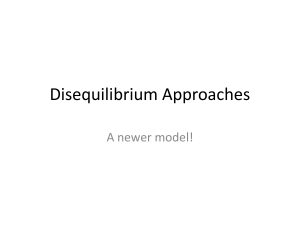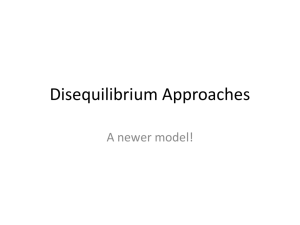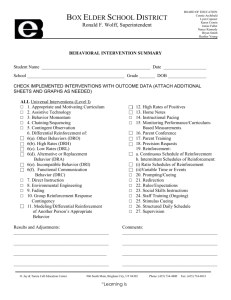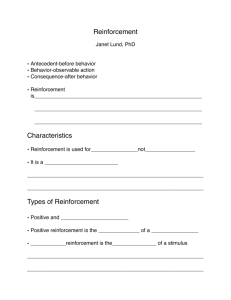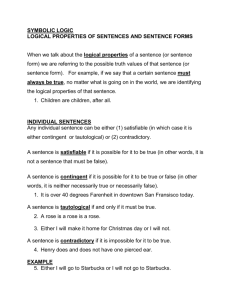Theories of Reinforcement
advertisement
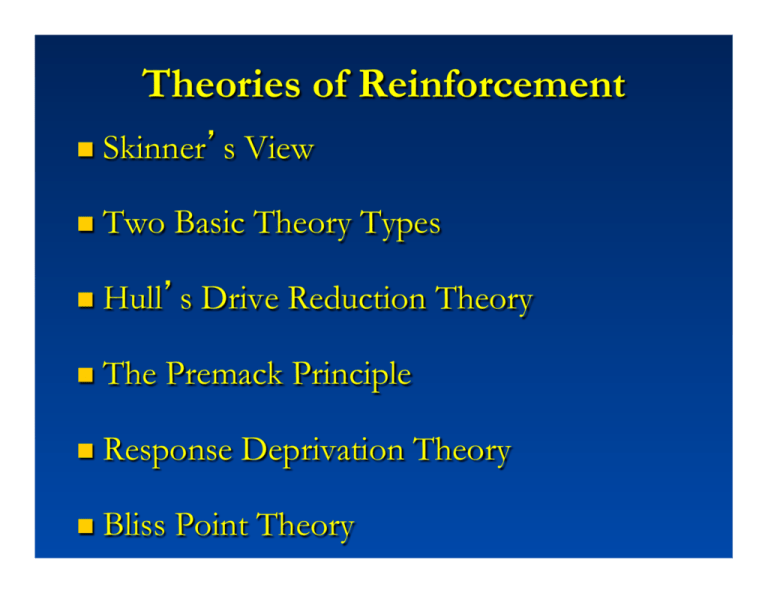
Theories of Reinforcement n Skinner’s n Two Basic Theory Types n Hull’s n The View Drive Reduction Theory Premack Principle n Response n Bliss Deprivation Theory Point Theory Skinner’s view of Reinforcement n No theory required n An empirical issue n If something acts to increase a B, then it’s a SR n Inductive viewpoint n A SR is a stimulus that reinforces the operant R Two Types of Theories n Reinforcers as Stimuli (Hull) n Reinforcers as Activities _________ SR = Eating the food n SR = Food _______ n SR = TV SR = Watching TV n Three Main “Reinforcers as Activities” Theories Hull’s Drive-Reduction Theory (A Reinforcers-as-Stimuli theory) n Stimuli that reduce a biological need, or that reduce strong aversive stimulation, will become reinforcers DRIVE n ACT DRIVE REDUCED (Pos. SR) Hunger à Lever press à Receive food (SR) DRIVE REDUCED (Neg. SR) Escape shock pain à Lever press à Shock ends (SR) DRIVE n ACT Hull’s Drive-Reduction Theory cont. n Three types of reinforcement: n Primary Reinforcers n Stimuli that reduce drives (food) n Stimuli that result in the reduction of another strong aversive stimulus (painkillers) n Secondary Reinforcers n Stimuli associated with drive-reducing stimuli (kitchen, cooking shows, meetings w/ snacks) A Problem with Hull’s Theory Researchers found stimuli that had high reinforcement value, yet did NOT reduce any drives: n Monkeys pulled chains to see lab and its workers n Rats lever pressed to stimulate pleasure centers Premack’s Principle n Reinforcement is a Contingency between two Bs n “Instrumental R;” “Contingent R” n Getting to do the second B is CONTINGENT upon first performing the INSTRUMENTAL B n Doing the first B is INSTRUMENTAL in your being able to perform the second (CONTINGENT) B n Can consider Contingent activity as the Reinforcer Premack’s Principle cont. n Not all behaviors are reinforcers! n More probable Bs reinforce less probable Bs n Contingent B should have higher probability than the Instrumental B n n Instrumental B (↓ prob.) à Contingent B (↑ prob.) How to measure these probabilities? n Free Baseline (aka Paired Baseline) Premack’s Principle cont. The Bottom Line: n Getting to perform the More probable B is CONTINGENT upon performing the Less probable, INSTRUMENTAL B n To demonstrate a significant Contingency Effect, you MUST perform the Instrumental B ABOVE baseline level! Shortfalls of Premack’s Principle n Premack assumed that the more preferred activities were those that people spent more time doing during baseline n Doing homework: 30 minutes - multiple hours n Having sex: ? min./hours (typically < homework) Shortfalls of Premack’s Principle cont. n Premack did NOT attach time amts. to his Bs n Free baseline: Run 60 min., Drink 30 min. n Contingency: Drink 15 min. à Run 30 min. n Result – Rat drank 30 min., then ran 60 min. n No increase above baseline => No contingency effect Response-Deprivation Theory (Timberlake & Allison) n n A Reinforcement Effect will occur ONLY when the reinforcement contingency deprives the S of the contingent activity n Performing baseline amt. of Instrumental R earns you less than baseline amount of Contingent R n Make S perform Instrumental B at a higher level than its baseline to obtain at least the baseline level of the Contingent B Can↑ time req’d for BI, or↓ time allowed for BC Response-Deprivation Theory cont. n n Premack: Behavior probabilities; Response Deprivation : Behavior preferences contingent activity doesn’t have to be more probable n ANY activity can be reinforcing, as long as the subject is deprived of performing it at baseline Response-Deprivation cont. n Use less-preferred activity as Instrumental B to gain access to the more-preferred Contingent B n Employ these in ratios that are above baseline n Subjects do not always perform contingencies as predicted/calculated by Response-Deprivation n Subjects instead alter their behaviors to compromise Bliss Point Theory (Allison) n Baseline = behavioral ideal n Behavioral ideal drives performance n Any contingency imposed disrupts bliss point n S increases frequency of BI as a compromise n Point of Minimum Deviation n Accurately predicted by formulae
